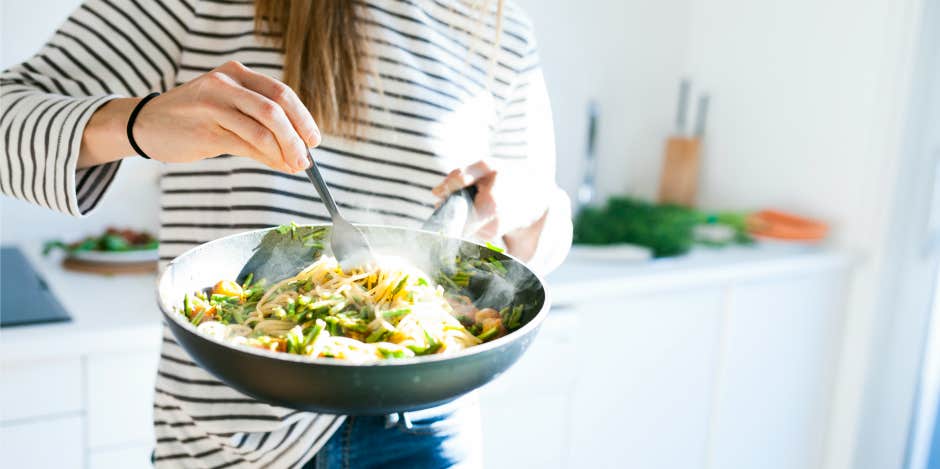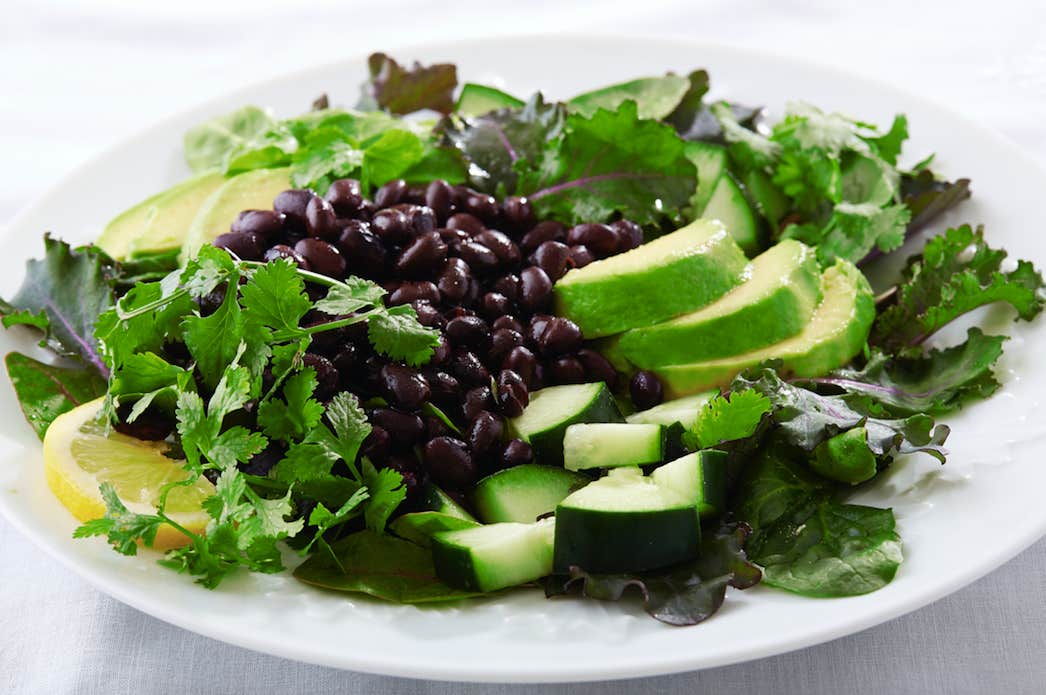The 3 Best Organic Vegan Recipes That Are High-Protein And Healthy
You're going to LOVE eating healthy!
 Getty
Getty If you grew up like me, I was told all my life that I needed protein. I also had acute anemia beginning at the age of 2, so people told me I had to eat liver and meat for the iron. I was told that meat, chicken, fish, dairy and eggs were a good source of the “best” protein. But contrary to what people had told me, I have found over the last 30 years that, in fact, plant-based, vegan protein is the healthiest protein for me.
There are several myths about protein.
For instance, in the 1971 book, Diet for a Small Planet, Frances Moore Lappé wrote that plants contained “incomplete proteins” with inadequate amounts of specific essential amino acids for them to meet the dietary needs of people. She emphasized the need to combine vegetable-based foods to obtain the complete amino acid complexes needed for optimum health when choosing not to consume animal protein.
However, according to more modern research by Dr. John McDougall, Lappé did not understand the scientific research on human protein needs and the sufficiency of plant-based foods. Dr. McDougall says that plant combining “is unnecessary and implies that it is difficult to obtain ‘complete’ proteins from vegetables without detailed nutritional knowledge. Because of her complicated and incorrect ideas, people are frightened away from vegetable-based diets.”
Thankfully such myths are slowly but surely being dismissed as untrue. The American Dietetic Association (ADA) revised its position statement on vegetarian diets and now agrees that well-planned vegetarian diets are “a healthy, nutritionally adequate dietary practice for all stages of life.”
In addition to this, according to Mladen Golubic, MD, PhD of the Cleveland Heart Clinic: A national (US) dietary survey was completed with over 6,000 people between the ages of 50 and 65 years old. It was found that those who reported high protein intake (example: eggs, dairy, fowl, pork, cows, lamb, etc.), increased their risk of death by any disease by 75 percent.
The study showed a quadruple increase of cancer death during the following 18 years and a quintuple increase of death from diabetes. The participants with a moderate intake of protein had a triple increase in their risk of death due to cancer when compared with the low protein intake group. “It is important to note that these associations of death by disease were completely eradicated if the ingested proteins were "plant-derived," Dr. Golubic says.
He explained that the composition of complex amino acids, (which are the building blocks of protein), that is derived from animals, acts very differently than the amino acids from plant protein. What we need are amino acids, not the proteins themselves. These foods can benefit our lives in wonderful ways.
Plant-based foods are extremely high in complex amino acids, and can provide quality protein, as well as other nutrients.
I can’t tell you how many people I have met who have told me they used to be vegetarian or vegan, but they had to go back to eating meat because they didn’t feel healthy or were hungry all the time.
In actuality, it can be quite easy to get all of the nutrients you need if you just know what nutrients your body requires and where to get them.
Legumes are one of the best sources of protein for a vegan diet.
The health benefits of legumes, which most of us know as beans, peas, or lentils, are that they are high in fiber, amino acids (which are the chemicals that combine to create protein), folate (Vitamin B9), zinc, iron, and magnesium.
- Beans: When beans are rich in color, then they are high in antioxidants as well, because the antioxidants are in the color pigment. Black beans have the highest number of antioxidants. Beans also help prevent blood sugar levels from rising too quickly after a meal, making beans a good food choice for people with diabetes or hypoglycemia.
- Lentils: Lentils are edible seeds — they come in black, red, brown, green and orange varieties — that belong to the legume family. They can help improve digestion, contribute to heart health, help control diabetes and contribute to weight loss. Plus, they're one of the oldest known sources of food, dating back more than 9,000 years. Lentils have an incredible amount of protein for a plant-based food and contain up to 35 percent of the complex amino acids (the building blocks of protein) your body needs — which is comparable to beef, poultry, fish and dairy.
- Nuts: Nuts are perfect foods because they are a combination of protein, fat, and carbohydrate. However, nuts contain delicate polyunsaturated fatty acids that can become rancid shortly after being shelled, so store them in a tightly sealed container (preferably glass) in the refrigerator. Almost all nuts contain enzyme inhibitors and phytic acid, which can prevent the body from absorbing some nutrients. To help diminish the phytic acid and enzyme inhibitors, and to make them more digestible, place them in a glass or steel bowl and soak them for 12–18 hours. When buying nuts and seeds, look for products that are sprouted or have been soaked.
Try these recipes below to incorporate more legumes into your diet:
1. Sprouted Beans
The optional seaweed in this recipe adds nutrients and helps make the beans more digestible. Serve them on top of a salad for a light lunch.

Ingredients:
- 1 lb. dried beans (any variety)
- Water, plus more for soaking and cooking
- 1 tsp. pure coconut oil
- 2-inch piece seaweed (optional)
- unrefined sea salt to taste
Directions:
1. Check beans and discard any that are shriveled or discolored. Also, make sure there are no little stones or foreign matter mixed in with the beans.
2. Sprout the beans, so they are more digestible. Beans have phytic acid that prevents them from being digested easily. Sprouting the beans makes them more nutritious as well as easier to digest.
Soak beans overnight or for a couple of days (Depending on the size of the bean, large beans need to soak at least 2 or 3 days to sprout) in pure water. Make sure the dish is large enough for beans to double or triple in size and can hold enough water to cover them by at least two inches. Check them each day and add more water as needed. When you see a tiny split or sprout, they are ready to cook.
3. Discard the water the beans were sprouted in.
4. Put the sprouted beans in a large pot and fill with enough new, purified water to cover the beans by about two inches. Add salt, coconut oil and seaweed, if using. Bring water to a boil.
5. Reduce heat to a simmer, and cook beans until tender, 45 minutes to an hour, depending on the size of beans. Larger beans will take longer. Add more water if it gets too low and the tops of beans are showing.
6. Remove from heat, and they are ready to eat.
Variation: Add a little extra virgin or pure coconut oil for additional richness.
2. Nutty Sweet Rice with Lentils
I also add some coconut oil for the savoriness it adds to the recipe. In addition to making the dish taste more satisfying, coconut oil increases energy levels, improves skin health, helps in stress reduction, increases good cholesterol, can aid in preventing liver disease, eases asthma symptoms, and can help control blood sugar.
Ingredients:
- 2 c. whole-grain, medium, sprouted brown rice
- 1⁄4 c. sprouted lentils (To sprout lentils, soak them overnight in pure water and then drain off the water before cooking in fresh water. This removes the phytic acid.)
- 1⁄4 tsp. unrefined sea salt
- 6 c. non-chlorinated water
- 1–2 vegetable bouillon cubes
- 1 T. extra virgin, pure, organic coconut oil
- 1⁄2 c. pecans or walnuts, finely chopped
- 1⁄2 c. raisins
- 1⁄4 c. raw coconut flakes
Directions:
1. Rinse rice and lentils in a small-weave sieve until they run clean.
2. Dissolve bouillon cube in 6 c. water in a large pot.
3. Add rice, lentils, sea salt, coconut oil, and half of the nuts and raisins.
4. Bring to a boil; reduce heat to a simmer.
5. Cover the pot and do not disturb for 35–40 minutes. Do not stir.
6. When it looks as if all the water is absorbed, rice and lentils are ready.
7. Add ghee, if using, to rice and lentil mixture and gently toss.
8. Gently scoop out rice and lentils, and add coconut and remaining nuts and raisins.
Variation: Add a little sauteed onion after cooking for a richer flavor.
3. Nut Pâté
This is an easy, rich, and savory snack or appetizer that's vegan, gluten-free and raw. You could also serve this with crackers or with chopped vegetables as a dip. Just be sure to start this recipe a day ahead of time, so you can soak the nuts in water to remove the phytic acid, or buy already sprouted nuts.
Ingredients:
- 2 c. sprouted pecans (If your pecans are not sprouted, soak them for 12–18 hours in water. Then drain them and dry them in a dehydrator or in an oven on low heat.)
- 1 red bell pepper, cored, seeded and chopped
- 2 large stalks celery, chopped
- 2 T. fresh lemon juice
- 1 tsp. unrefined sea salt
- dash of mesquite powder (optional)
Directions:
1. Combine all ingredients in a food processor.
2. Add a little water if necessary.
Nancy Addison is a certified health counselor, as well as a certified practitioner of Psychosomatic Therapy with the Australasian Institute of Body-Mind Analysis and Psychosomatic Therapy. She also holds a lifelong teaching certification in the state of Texas. Nancy has written award-winning books on health, nutrition and cooking. You can reach her on her website, Organic Healthy Life, or find more easy, healthy recipes in Nancy's book, How To Be A Healthy Vegetarian.
The information from Nancy Addison and Organic Healthy Lifestyle LLC is not offered for the diagnosis, cure, mitigation, treatment, or prevention of any disease or disorder nor have any statements herein been evaluated by the Food and Drug Administration (FDA). We strongly encourage you to discuss topics of concern with your health care provider.
Medical Disclaimer: Information provided in this article, book, website, email, etc. is for informational purposes only. The information is a result of years of practice and experience by Nancy Addison CHC, AADP. However, this information is NOT intended as a substitute for the advice provided by your physician or other healthcare professional, or any information contained on or in any product label or packaging.

